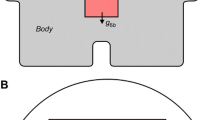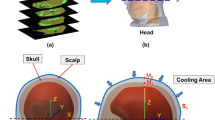Abstract
Brain hypothermia induced by a temperature reduction of the spinal fluid using a torso-cooling pad is evaluated as a cooling alternative for traumatic injury patients. A theoretical model of the human head is developed to include its tissue structures and their contribution to local heat transfer. The Pennes bioheat equation and finite element analysis are used to predict the temperature distribution in the head region. The energy balance in the cerebrospinal fluid (CSF) layer surrounding the brain during mixing of the CSF and cold spinal fluid is also formulated to predict the CSF temperature reduction. Results show that the presence of cooled CSF around the brain provides mild cooling (~1°C) to the grey matter within 3000 s (50 min) with a cooling capacity of approximately 22 W. However, large temperature variations (~3.5°C) still occur in the grey matter. This approach is more effective during ischemia because it promotes deeper cooling penetration and results in larger temperature reductions; the average grey matter temperature decreases to 35.4°C. Cooling in the white matter is limited and only occurs under ischemic conditions. The non-invasive nature of the torso-cooling pad and its ability to quickly induce hypothermia to the brain tissue are beneficial to traumatic injury patients.







Similar content being viewed by others
References
Allers M, Boris-Möller F, Lunderquist A et al (2006) A new method of selective, rapid cooling of the brain: an experimental study. Cardiovasc Interv Rad 29:260–263
Busto R, Dietrich W, Globus M et al (1989) The importance of brain temperature in cerebral ischemic injury. Stroke 20:1113–1114
Cheng H, Shi J, Zhang L et al (2006) Epidural cooling for selective brain hypothermia in porcine model. Acta Neurochir 148:559–564
Davies A (2005) Hypothermia improves outcome from traumatic brain injury. Crit Care Resusc 7:238–243
Diao C, Zhu L, Wang H (2003) Cooling and rewarming for brain ischemia or injury: theoretical analysis. Ann Biomed Eng 31:346–353
Diao C, Zhu L (2006) Temperature distribution and blood perfusion response in rat brain during selective brain cooling. Med Phys 33:2565–2573
Dietrich W (1992) The importance of brain temperature in cerebral injury. J Neurotraum 9:S475–S485
Dietrich W, Atkins C, Bramlett H (2009) Protection in animal models of brain and spinal cord injury with mild to moderate hypothermia. J Neurotraum 26:301–312
Diller K, Zhu L (2009) Hypothermia therapy for brain injury. Annu Rev Biomed Eng 11:135–162
Dohi K, Jimbo H, Abe T et al (2006) Positive selective brain cooling method: a novel, simple, and selective nasopharyngeal brain cooling method. Acta Neurochir 96:406–412
Fu E, Tummala R (2005) Neuroprotection in brain and spinal cord trauma. Curr Opin Anaesthesiol 18:181–187
Ghajar J (2000) Traumatic brain injury. Lancet 356:923–929
Goetz T, Romero-Sierra C, Ethier R et al (1988) Modeling of therapeutic dialysis of cerebrospinal fluid by epidural cooling in spinal cord injuries. J Neurotraum 5:139–150
Gupta A, Al-Rawi P, Hutchinson P et al (2002) Effect of hypothermia on brain tissue oxygenation in patients with sever head injury. Br J Anaesth 88:188–192
Henderson W, Dhingra V, Chittock D et al (2003) Hypothermia in the management of traumatic brain injury: a systematic review and meta-analysis. Intensive Care Med 29:1637–1644
Hutchinson J, Ward R, Lacroix J, Hebert P, Barnes M, Bohn D, Dirks P, Doucette S, Fergusson D, Gottesman R, Joffe A, Kirpalani H, Meyer P, Morris K, Moher D, Singh R, Skippen P (2008) Hypothermia therapy after traumatic brain injury in children. New Engl J Med 358:2447–2456
Incropera F, DeWitt D (1996) Fundamentals of heat and mass transfer, 4th edn. Wiley, New York
Kuluz J, Prado R, Chang J et al (1993) Selective brain cooling increases cortical cerebral blood flow in rats. Am J Physiol 265:H824–H827
Laptook A, Shalak L, Corbett R (2001) Differences in brain temperature and cerebral blood flow during selective head versus whole-body cooling. Pediatrics 108:1103–1110
Linninger A, Tsakiris C, Zhu D et al (2005) Pulsatile cerebrospinal fluid dynamics in the human brain. IEEE Trans Biomed Eng 52:557–565
Linninger A, Xenos M, Zhu D et al (2007) Cerebrospinal fluid flow in the normal and hydrocephalic human brain. IEEE Trans Biomed Eng 54:291–302
Liu W, Qiu W, Zhang Y et al (2006) Effects of selective brain cooling in patients with severe traumatic brain injury: a preliminary study. J Int Med Res 34:58–64
Loth F, Yardimmci M, Alperin N (2001) Hydrodynamic modeling of cerebrospinal fluid motion within the spinal cavity. J Biomech Eng 123:71–79
Magnæs B (1989) Clinical studies of cranial and spinal compliance and the craniospinal flow of cerebrospinal fluid. Br J Neurosurg 3:659–668
Nelson D, Nunneley S (1998) Brain temperature and limits on transcranial cooling in humans: quantitative modeling results. Eur J Appl Physiol 78:353–359
Pennes H (1948) Analysis of tissue and arterial blood temperatures in the resting human forearm. J Appl Physiol 1:93–122
Polderman K (2004) Application of therapeutic hypothermia in the ICU: opportunities and pitfalls of a promising treatment modality. Part 1: indications and evidence. Intensive Care Med 30:556–575
Povolny M, Kaplan S (1993) Traumatic brain injury occurring with spinal cord injury: significance in rehabilitation. J Rehabil 59:1–8
Saunders N, Habgood M, Dziegielewska K (1999) Barrier mechanisms in the brain. Clin Exp Pharmacol Physiol 26:11–19
Schellinger D, LeBihan S, Rajan S et al (1992) MR of slow CSF flow in the spine. Am J Neuroradiol 13:1393–1403
Smith K, Zhu L (2010) Theoretical evaluation of a simple cooling pad for inducing hypothermia in the spinal cord following traumatic injury. Med Biol Eng Comput 48:167–175
Sukstanskii A, Yablonskiy D (2004) An analytical model of temperature regulation in human head. J Therm Biol 29:583–587
Van Leeuwen G, Hand J, Lagenduk J et al (2000) Numerical modeling of temperature distributions within the neonatal head. Pediatr Res 48:331–356
Wang H, Olivero W, Lanzion G et al (2004) Rapid and selective cerebral hypothermia achieved using a cooling helmet. J Neurosurg 100:272–277
Wang Y, Zhu L (2007) Targeted brain hypothermia induced by an interstitial cooling device in human neck: theoretical analyses. Eur J Appl Physiol 101:31–40
Xu X, Tikusis P, Giesbrecht G (1999) A mathematical model for human brain cooling during cold-water near-drowning. J Appl Physiol 86:265–272
Zenker W, Kubik S (1996) Brain cooling in humans—anatomical considerations. Anat Embryol 193:1–13
Zhu L, Diao C (2001) Theoretical simulation of temperature distribution in the brain during mild hypothermia treatment for brain injury. Med Biol Eng Comput 39:681–687
Zhu L, Rosengart A (2008) Cooling penetration into normal and injured brain via intraparenchymal brain cooling probe: theoretical analyses. Heat Transfer Eng 29:284–294
Acknowledgements
This research was supported in part by the State of Maryland TEDCO fund, an NIGMS Initiative for Minority Student Development Grant (R25-GM55036), and Procter and Gamble. This research was performed in partial fulfillment of the requirements for the Ph.D. degree from the University of Maryland, Baltimore County by Katisha D. Smith.
Author information
Authors and Affiliations
Corresponding author
Rights and permissions
About this article
Cite this article
Smith, K.D., Zhu, L. Brain hypothermia induced by cold spinal fluid using a torso cooling pad: theoretical analyses. Med Biol Eng Comput 48, 783–791 (2010). https://doi.org/10.1007/s11517-010-0635-9
Received:
Accepted:
Published:
Issue Date:
DOI: https://doi.org/10.1007/s11517-010-0635-9




